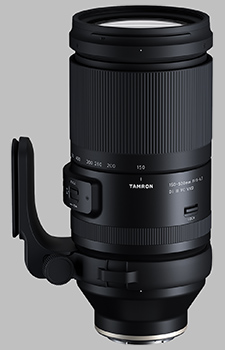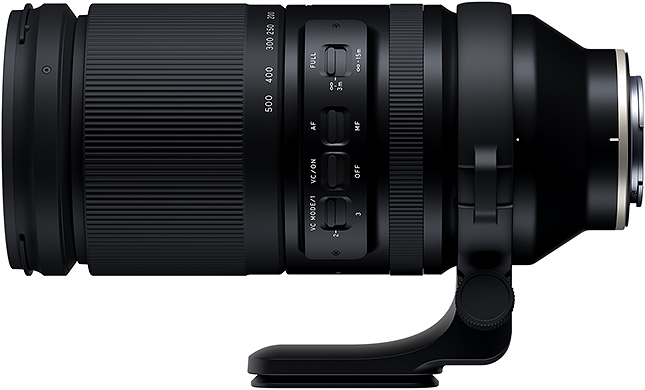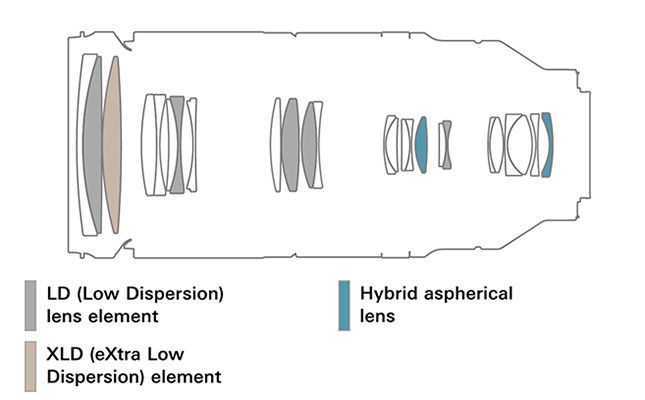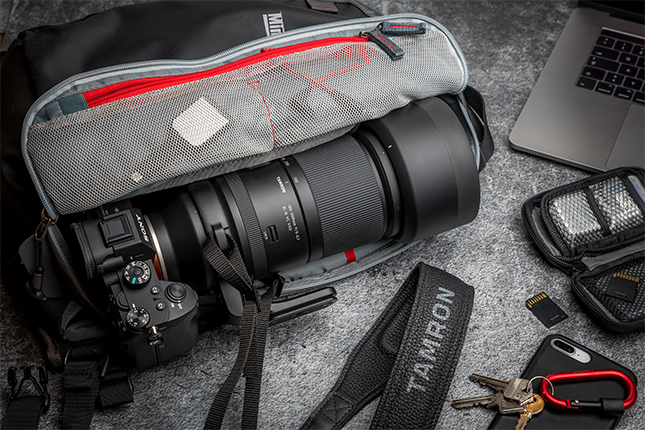| 150-500mm |
$1,249 average price |
|---|---|

|
|
Your purchases support this site
Buy the Tamron 150-500mm f/5-6.7 Di III VC VXD (Model A057)
Updates:
07/01/2021: Field Test & Gallery Images added
Tamron 150-500mm f/5-6.7 Di III VC VXD Field Test
Tamron's new telephoto zoom delivers impressive performance and excellent value
by Jeremy Gray | Posted 07/01/2021
| Shot on Sony A7R IV at 478mm, f/6.3, 1/500s, ISO 5000. This image has been converted and processed to taste in Adobe Camera Raw. Click for the full-size image. Click here for the RAW file. |
Earlier this year, Tamron announced a new telephoto zoom for full-frame Sony mirrorless cameras, the Tamron 150-500mm f/5-6.7 Di III VC VXD (Model A057). This new E-mount lens offers a surprisingly compact and lightweight design for an ultra-telephoto zoom lens.
We recently had the opportunity to go hands-on with the Tamron 150-500mm lens paired up the Sony A7R IV. During my time with the lens, it continually impressed me in terms of optical performance and autofocus.
| Shot on Sony A7R IV at 500mm, f/6.7, 1/500s, ISO 1000. This image has been converted and processed to taste in Adobe Camera Raw. Click for the full-size image. Click here for the RAW file. |
The lens works well for many situations, provided you have enough light for the somewhat slow maximum aperture. I primarily used the lens for wildlife photography, although it can also work well for landscapes. I didn't have the opportunity to test the lens for sports photography, but given its autofocus performance, I think it'd work well there, too, at least during the daytime.
| Shot on Sony A7R IV at 500mm, f/6.7, 1/800s, ISO 2500. This image has been converted and processed to taste in Adobe Camera Raw. Click for the full-size image. Click here for the RAW file. |
What is perhaps most impressive about the Tamron 150-500mm is that it delivers high-end performance at a very affordable price. The lens costs $1,400, which isn't inexpensive, but it's a great price in the realm of ultra-tele zoom lenses. The lens represents a terrific value, especially given how well it performs in the field. Speaking of which, let's dive in.
| Shot on Sony A7R IV at 500mm, f/6.7, 1/640s, ISO 2000. This image has been converted and processed to taste in Adobe Camera Raw. Click for the full-size image. Click here for the RAW file. |
Tamron 150-500mm f/5-6.7 Di III VC VXD Key Features and Specifications
- Compact ultra-telephoto zoom lens for full-frame Sony mirrorless cameras
- 209.6mm (8.3”) long, although it extends in use to 282mm (11.1")
- 93mm maximum diameter
- 1.88kg (4.14 lbs.)
- 25 elements in 16 groups
- Includes hybrid aspherical, eXtra Low Dispersion (XLD), Low Dispersion (LD) and Glass-Molded Aspherical (GM) elements
- BBAR-G2 coating to reduce ghosting, flare and internal reflections
- Utilizes a linear motor focus mechanism (Voice-coil eXtreme-torque Drive (VXD))
- Minimum object distance of 0.6m (23.6”) at 150mm
- 1:3.1 maximum reproduction ratio
- Has vibration compensation (VC) with three modes
- 7-bladed circular aperture diaphragm
- Includes an Arca-Swiss compatible tripod mount with strap attachment holes
- Moisture-resistant construction
- $1,400
| Shot on Sony A7R IV at 411mm, f/6.3, 1/500s, ISO 4000. Click for the full-size image. Click here for the RAW file. |
Lens design and handling
The Tamron 150-500mm Di III VC VXD features the same styling as other recent Tamron lenses. It has a satin black finish, ridged zoom and focus rings, a removable Arca-Swiss tripod mount and newly designed switches. The lens's switches include a focus range limiter, AF/MF switch, VC switch and VC mode switch. The lens includes a removable lens hood with a rubbery and flexible front end, making it much less likely to crack or break if you bump the front of the hood on something.
| The Tamron 150-500mm lens is reasonably compact for a full-frame telephoto zoom lens. It features Tamron's familiar styling and it looks quite nice paired with the Sony A7R IV. |
The lens large zoom ring has markings at 150, 200, 250, 300, 400 and 500mm focal lengths. Going from 150mm to 500mm requires only 75 degrees of rotation, making it fast to go from the widest to longest focal length. Speaking of focal length, a Flex Zoom Lock mechanism allows you to lock the lens at any focal length, which is handy. To lock the lens at a specific focal length, you push the zoom ring forward, exposing a white line, letting you know that the lens is locked. You can also use a locking switch on the right side of the lens to lock it at 150mm, which is primarily useful when traveling.
| The Tamron 150-500mm lens gets a bit longer when you zoom in from 150mm to 500mm, which makes the lens a bit front-heavy. |
Closer to the lens mount is a focus ring. The focus ring has a slightly different ridged surface than the zoom ring. The focus ring rotates smoothly, although it doesn't feel loose. There aren't any hard stops, so the focus ring rotates indefinitely.
Going back to the tripod mount, the Arca-Swiss-compatible foot is quite nice. The mount feels rugged and includes strap attachment holes. There are small white dots every 90 degrees, making it easier to lock the tripod mount at specific orientations. The most important aspect of a tripod mount is stability, and the Tamron 150-500's mount proved to be sturdy.
150-500mm is a large focal length range for a full-frame lens, so it should be no surprise that the Tamron 150-500mm isn't particularly compact or lightweight. With that said, it balances nicely on the Sony A7R IV, at least at most focal lengths. At 500mm, the lens feels a bit front-heavy. At its smallest, the lens is 209.6mm (8.3") long, but when you zoom to 500mm, the lens extends to 282mm (11.1") long. The lens has a 93mm (3.7") maximum diameter and features an 82mm filter thread. The lens weighs 1.88 kg (4.14 lbs.)
Before finishing up this section of the Field Test, it's worth considering how the Tamron 150-500mm stacks up in terms of size and weight against its primary Sony-branded competition, the 100-400mm f/4.5-5.6 GM OSS ($2,500) and 200-600mm f/5.6-6.3 G OSS ($2,000). Compared to the Tamron lens, the 100-400mm lens has less reach but a faster maximum aperture. The 100-400mm lens weighs 1.39kg (3.08 lbs.) and is 205mm (8.07") long. The 200-600mm lens is heavier, weighing 2.12kg (4.65 lbs.). The lens is also longer, at 318mm (12.52").
Overall, the build quality of the Tamron 150-500mm Di III VXD lens is impressive, especially for its price. Even at $1,400, the lens still features moisture-resistant construction via leak-resistant seals at the mount and throughout the barrel on the edges of rings and seams.
Image quality: Impressive performance across the board
Inside the Tamron 150-500mm lens are 25 elements in 16 groups. Among these elements are numerous specialized pieces of glass, including hybrid aspherical elements to control chromatic aberrations. The lens also includes eXtra Low Dispersion (XLD), Low Dispersion (LD) and Glass-Molded Aspherical (GM) elements. The lens also features Tamron's Broad-Band Anti-Reflection (BBAR-G2) coating to suppress internal reflections, flare and ghosting.
| Shot on Sony A7R IV at 150mm, f/5, 1/800s, ISO 800. This image has been converted and processed to taste in Adobe Camera Raw. Click for the full-size image. Click here for the RAW file. |
This special glass and complex optical design results in impressive image quality throughout the focal length range. Plus, the lens works with Sony's in-camera lens correction for shading (vignette), chromatic aberration and distortion. With modern lenses, it can sometimes be difficult to tell precisely what sort of image quality work is being done by the camera and how much it's correcting optical issues. Still, all that matters is the final image quality. With the Tamron 150-500mm, the final image quality is great.
| Shot on Sony A7R IV at 341mm, f/5.6, 1/1000s, ISO 640. Click for the full-size image. Click here for the RAW file. |
All the crops seen below are 100 percent crops from raw image files converted in Adobe Camera Raw using default settings and built-in lens correction profiles enabled. I have selected specific images to show, but you can download the full-size raw files for each focal length/aperture combination I tested in the Gallery.
150mm
At its maximum aperture of f/5, the Tamron 150-500mm lens is reasonably sharp across the frame at 150mm. There is a slight softness, at least when compared to the image quality at f/5.6 and f/8, but it's usable and quite impressive overall. It's worth noting that the corner sharpness is good at f/5, too, which is surprising for a telephoto lens at either extreme focal length. There's slight corner darkening (vignette), but it's not very noticeable. I suspect that in-camera corrections are doing a fair bit of work here.
| Shot on Sony A7R IV at 150mm, f/5, 1/640s, ISO 100. Full test scene at 150mm. Click for the full-size image. Click here for the RAW file. |
| Shot on Sony A7R IV at 150mm, f/5, 1/640s, ISO 100. 100% center crop at 150mm. Click for the full-size image. Click here for the RAW file. |
| Shot on Sony A7R IV at 150mm, f/5, 1/640s, ISO 100. 100% bottom right corner crop at 150mm. Click for the full-size image. Click here for the RAW file. |
By stopping down to f/5.6, there's a bit more detail evident in the scene. It's a small improvement, but it can make a difference in scenes with very fine detail. To my eyes, contrast and overall color also improve slightly by stopping down. Corner performance remains impressive.
| Shot on Sony A7R IV at 150mm, f/5.6, 1/300s, ISO 100. 100 percent center crop at 150mm. Click for the full-size image. Click here for the RAW file. |
| Shot on Sony A7R IV at 150mm, f/5.6, 1/300s, ISO 100. 100 percent bottom right corner crop at 150mm. Click for the full-size image. Click here for the RAW file. |
Taking it a step further and stopping down to f/8 resolves a bit more detail. The improvements are still subtle as you stop down, but they are evident in certain situations.
| Shot on Sony A7R IV at 150mm, f/8, 1/320s, ISO 100. 100 percent center crop at 150mm. Click for the full-size image. Click here for the RAW file. |
| Shot on Sony A7R IV at 150mm, f/8, 1/320s, ISO 100. 100 percent bottom right corner crop at 150mm. Click for the full-size image. Click here for the RAW file. |
Overall, performance at 150mm is impressive. While stopping down results in slight increases to sharpness, at least until around f/11 when diffraction can begin to be seen, I wouldn't hesitate to use this lens wide open if you need the background blur or light-gathering abilities.
300mm
At 300mm, or 297mm, to be exact, the Tamron 150-500mm lens performs well. Sharpness remains good across the frame when shooting wide open at f/5.6. Honestly, there's very little to say about 300mm that hasn't been said about 150mm. The lens delivers good detail, color and contrast across the frame without noticeable vignette or issues with chromatic aberrations.
| Shot on Sony A7R IV at 297mm, f/5.6, 1/300s, ISO 100. Full test scene at 300mm. Click for the full-size image. Click here for the RAW file. |
| Shot on Sony A7R IV at 297mm, f/5.6, 1/300s, ISO 100. 100 percent center crop at 300mm. Click for the full-size image. Click here for the RAW file. |
| Shot on Sony A7R IV at 297mm, f/5.6, 1/300s, ISO 100. 100 percent bottom right corner crop at 300mm. Click for the full-size image. Click here for the RAW file. |
| Shot on Sony A7R IV at 297mm, f/8, 1/200s, ISO 100. 100 percent center crop at 300mm. Click for the full-size image. Click here for the RAW file. |
| Shot on Sony A7R IV at 297mm, f/8, 1/200s, ISO 100. 100 bottom right corner center crop at 300mm. Click for the full-size image. Click here for the RAW file. |
| Shot on Sony A7R IV at 297mm, f/11, 1/80s, ISO 100. 100 percent center crop at 300mm. Click for the full-size image. Click here for the RAW file. |
| Shot on Sony A7R IV at 297mm, f/11, 1/80s, ISO 100. 100 percent bottom right corner crop at 300mm. Click for the full-size image. Click here for the RAW file. |
500mm
If you're purchasing a telephoto zoom lens, you're likely primarily interested in how the lens performs at its longest focal length, or at least close to it. At 500mm, there is a bit of a change in image quality with the Tamron 150-500mm lens.
| Shot on Sony A7R IV at 500mm, f/6.7, 1/400s, ISO 100. Full test scene at 500mm. Click for the full-size image. Click here for the RAW file. |
Center sharpness at the somewhat slow maximum aperture of f/6.7 is good. There's a good amount of detail visible, and the lens exhibits good control of aberrations. However, moving to the extreme corner of the frame, it's quite a bit softer than the corners at 150mm and 300mm. For most subjects shot at 500mm, corner sharpness isn't a big deal, but it's something to keep in mind.
| Shot on Sony A7R IV at 500mm, f/6.7, 1/400s, ISO 100. 100 percent center crop at 500mm. Click for the full-size image. Click here for the RAW file. |
| Shot on Sony A7R IV at 500mm, f/6.7, 1/400s, ISO 100. 100 percent bottom right corner crop at 500mm. Click for the full-size image. Click here for the RAW file. |
By stopping down to f/8, center sharpness improves slightly, although corner performance remains soft. This is true still at f/11. In fact, at 500mm, there's not a lot you can do to improve corner performance. Well, you could shoot on an APS-C camera body, as that image frame is excellent, but if you're using the lens on a full-frame camera in a full-frame image area, soft corners are just the reality of a $1,400 supertelephoto zoom lens. You can't have it all.
| Shot on Sony A7R IV at 500mm, f/8, 1/320s, ISO 100. 100 percent center crop at 500mm. Click for the full-size image. Click here for the RAW file. |
| Shot on Sony A7R IV at 500mm, f/8, 1/320s, ISO 100. 100 percent bottom right corner crop at 500mm. Click for the full-size image. Click here for the RAW file. |
| Shot on Sony A7R IV at 500mm, f/11, 1/160s, ISO 100. 100 percent center crop at 500mm. Click for the full-size image. Click here for the RAW file. |
| Shot on Sony A7R IV at 500mm, f/11, 1/160s, ISO 100. 100 percent bottom right corner crop at 500mm. Click for the full-size image. Click here for the RAW file. |
Image quality summary
Although you can't have it all with any zoom lens, the Tamron 150-500mm f/5-6.7 Di III VC VXD gives you an awful lot for the money. The lens exhibits good center sharpness across its entire focal length range and edge-to-edge sharpness across much of its zooming range. The lens also displays very good control of aberrations and distortion. This lens is an impressive performer.
| Shot on Sony A7R IV at 500mm, f/6.7, 1/800s, ISO 800. This image has been converted and processed to taste in Adobe Camera Raw. Click for the full-size image. Click here for the RAW file. |
In the field: Speedy autofocus and good vibration compensation
Autofocus
Autofocus is driven by Tamron's Voice-coil eXtreme-torque Drive (VXD) linear motor focus mechanism. VXD promises high-speed, precise movement for responsive focus. Across the focal length range, in real-world use with the A7R IV, the Tamron 150-500mm delivers quick and accurate autofocus.
| Shot on Sony A7R IV at 457mm, f/6.3, 1/640s, ISO 2500. This image has been converted and processed to taste in Adobe Camera Raw. Click for the full-size image. Click here for the RAW file. |
I am particularly impressed by how quick the autofocus performance is at 500mm. Switching between focusing on a close subject and a distant one is generally fast, which bodes well for sports photography. The lens isn't the fastest I've used, but it's still swift.
| Shot on Sony A7R IV at 500mm, f/6.7, 1/800s, ISO 4000. This image has been converted and processed to taste in Adobe Camera Raw. Click for the full-size image. Click here for the RAW file. |
Subject tracking performance is very good with the A7R IV. The 150-500mm, since it was designed for Sony mirrorless cameras, delivers a nice mix of features. The lens is compatible with Sony's Fast Hybrid AF, Eye AF and Direct Manual Focus (DMF) features.
| Shot on Sony A7R IV at 392mm, f/6.3, 1/1000s, ISO 1600. This image has been converted and processed to taste in Adobe Camera Raw. Click for the full-size image. Click here for the RAW file. |
In terms of close focusing performance, the lens can focus as close as 0.6m (23.6") at 150mm and 1.8m (70.9") at 500mm. This is impressive for a telephoto zoom lens. At 150mm, the maximum magnification ratio is 1:3.1. It's not quite macro territory, but it delivers impressive close-up performance.
| Shot on Sony A7R IV at 153mm, f/5, 1/800s, ISO 500. This image has been converted and processed to taste in Adobe Camera Raw. Click for the full-size image. Click here for the RAW file. |
Overall, I am very pleased with the Tamron 150-500mm's autofocus performance. The lens is quick, quiet and accurate. Plus, it can focus quite closely, which adds to the lens's high versatility.
| Shot on Sony A7R IV at 150mm, f/5, 1/1600s, ISO 125. This image has been converted and processed to taste in Adobe Camera Raw. Click for the full-size image. Click here for the RAW file. |
Image Stabilization
The Tamron 150-500mm includes built-in Vibration Compensation (VC) to help keep your shots steady and sharp. This is especially important when shooting at long focal lengths, as even a little bit of shake can lead to a noticeable decrease in sharpness. It's also important because the lens is a bit slow in terms of aperture, meaning that you may need to use slower shutter speeds regularly.
| Shot on Sony A7R IV at 500mm, f/6.7, 1/500s, ISO 6400. This image has been converted and processed to taste in Adobe Camera Raw. Click for the full-size image. Click here for the RAW file. |
The lens includes three VC modes, plus the ability to turn VC off entirely if desired. All these options are accessible via physical switches on the lens. The three VC modes include Standard (Mode 1), Panning (2) and Framing priority (3). Mode 3 makes it such that VC is working as soon as you turn the camera on. It makes a bit of noise and can drain the battery faster, but it makes it very easy to frame subjects since the viewfinder image is stable, even when you're not shooting.
In the Field: The Tamron 150-500mm f/5-6.7 Di III VC VXD is a versatile, enjoyable lens
There's a lot to like about using the Tamron 150-500mm lens. It has many strengths, not the least of which is versatility. While the lens doesn't have the fastest aperture range, it delivers strong sharpness and can produce decent bokeh in the right situation. If you get close to your subject, which is aided by the lens's good close focus distance, you can get a soft, pleasing background and good subject isolation.
| Shot on Sony A7R IV at 152mm, f/5, 1/500s, ISO 125. Click for the full-size image. Click here for the RAW file. |
You can use the lens for close-up shots, wildlife images, sports photos, and even landscapes. I suppose you could even use the lens for portraiture, although that use case is a bit out of its wheelhouse given the aperture range.
However, the Tamron 150-500mm is not the perfect choice for every telephoto situation. The lens's maximum aperture is not fast at either end of the focal length range, especially at 500mm when the lens slows down to f/6.7. The slowness of the lens can limit its usability in low light situations or when trying to shoot with high shutter speeds, meaning that it's not always well-suited to wildlife or sports situations. The lens undoubtedly performs best in bright light.
| Shot on Sony A7R IV at 500mm, f/6.7, 1/640s, ISO 800. This image has been converted and processed to taste in Adobe Camera Raw. Click for the full-size image. Click here for the RAW file. The bokeh performance is pretty good, although there is some onion ring bokeh, as you can see in the top portion of the background. |
That said, the ever-improving high ISO performance of modern image sensors reduces the need for fast lenses to some extent. Plus, the autofocus performance, even in low light, is impressive. The VC helps in low light, too.
| Shot on Sony A7R IV at 465mm, f/6.3, 1/800s, ISO 1600. This image has been converted and processed to taste in Adobe Camera Raw. Click for the full-size image. Click here for the RAW file. |
Ultimately, you can't have it all. A telephoto zoom lens can't be both affordable and have a fast maximum aperture. Likewise, a lens can't cover an impressive focal length range and be lightweight. The Tamron 150-500mm f/5-6.7 lens is designed to offer an impressive telephoto range for full-frame mirrorless cameras at relatively low cost and with a reasonably compact form factor, and that's precisely what it does.
| Shot on Sony A7R IV at 500mm, f/6.7, 1/800s, ISO 1000. Click for the full-size image. Click here for the RAW file. |
While not a small lens, the Tamron 150-500mm is easy enough to carry around for extended periods. You may not want it hanging off your neck for long periods, but the lens can be handheld for a while without causing discomfort. It also fits nicely into many medium-to-large camera bags.
| Shot on Sony A7R IV at 500mm, f/6.7, 1/800s, ISO 400. Click for the full-size image. Click here for the RAW file. |
Overall, using the Tamron 150-500mm lens is an enjoyable experience. The lens performs well in a diverse range of photo situations. It's not the fastest lens in terms of aperture, but its impressive sharpness and quick autofocus make it a great choice for Sony shooters.
| Shot on Sony A7R IV at 500mm, f/6.7, 1/800s, ISO 320. This image has been converted and processed to taste in Adobe Camera Raw. Click for the full-size image. Click here for the RAW file. |
Tamron 150-500mm f/5-6.7 Di III VC VXD Field Test Summary
Great performance at a reasonable price
What I like most about the lens:
- Good build quality with weather sealing and Flex Zoom lock
- Reasonably lightweight for its class
- Impressive sharpness
- Fast autofocus
- Can focus closely
- VC works well
- Affordable
| Shot on Sony A7R IV at 500mm, f/6.7, 1/1000s, ISO 8000. This image has been converted and processed to taste in Adobe Camera Raw. Click for the full-size image. Click here for the RAW file. |
What I dislike about the lens:
- Somewhat slow aperture
- Corner performance isn't great
As you can see in the pros and cons section above, there's a lot to like about the Tamron 150-500mm lens and very little holding it back. Is the lens as sharp and as fast as the Sony 100-400mm GM? No, but it's $1,000 less and has an extra 100mm of reach. It's also not as long as the 200-600mm lens, but the Tamron lens is $600 cheaper and significantly lighter and more compact. Tamron has done a great job balancing performance, price and size with its new telephoto zoom for Sony mirrorless cameras. If you want a telephoto zoom and don't need the fast aperture of the Sony GM lens or an exotic prime, it's hard to go wrong with Tamron's new lens. It's an excellent lens that is truly enjoyable to use.
| Shot on Sony A7R IV at 500mm, f/6.7, 1/500s, ISO 2500. This image has been converted and processed to taste in Adobe Camera Raw. Click for the full-size image. Click here for the RAW file. |
• • •
Tamron 150-500mm F5-6.7 Product Overview
(From Tamron lens literature) The Tamron 150-500mm F5-6.7 is TAMRON's first ultra-telephoto zoom lens for full-frame mirrorless cameras that reaches the 500mm focal length and when used on APS-C mirrorless format cameras, the zoom range is an approximate 225-750mm full-frame equivalent. Even when extended to the 500mm telephoto end, the lens is still compact enough for comfortable handheld shooting. This zoom lets users enjoy casual shooting with steady performance and high image quality in the ultra-telephoto realm where conventional wisdom once dictated a tripod. To support handheld shooting in the ultra-telephoto range, the 150-500mm is equipped with VXD (Voice-coil eXtreme-torque Drive), a linear motor focus mechanism that delivers excellent quietness and agile performance, and TAMRON's proprietary VC (Vibration Compensation) mechanism for high-level image stabilization. At the 150mm end, the lens offers an MOD of 23.6” for powerful and dramatic close-ups.
PRODUCT HIGHLIGHTS
1. A hand-holdable full-frame 500mm lens that defies conventional wisdom
The 150-500mm F5-6.7 is just 8.3” long with a maximum diameter of Ø93mm, an astoundingly compact size for a 500mm-class ultra-telephoto zoom for full-frame mirrorless cameras. Even when extended to the 500mm telephoto end, the lens is still remarkably compact at only 11.1”. The lens zooms from 150mm to 500mm by rotating the zoom ring through an arc of just 75° — less than one-quarter of a turn. This feature enables rapid adjustment to the desired angle of view with minimal movement, avoiding missed opportunities and facilitating intuitive composition. TAMRON’s renowned VC mechanism also significantly improves handheld performance by counteracting camera shake.
 |
2. Amazing high image quality despite its compact size
The optical construction features 25 elements in 16 groups. The generous and effective use of special lens elements including one XLD (eXtra Low Dispersion), five LD (Low Dispersion), and two Hybrid Aspherical lens elements thoroughly controls aberrations including axial chromatic aberrations. This 150-500mm F5-6.7 ultra-telephoto zoom lens is designed and constructed with strong emphasis on compact size and usability without compromising image quality, so users can enjoy exceptionally high resolving power across the entire image.
 |
3. VXD AF motor provides high speed, high precision, and excellent quietness
The 150-500mm F5-6.7 features the same highly acclaimed VXD linear motor focus mechanism that was first introduced in the 70-180mm F/2.8 Di III VXD (Model A056). VXD delivers extreme high-speed and high-precision movement and ensures exceedingly responsive performance. Even when shooting at the ultra-telephoto end with a focal length of 500mm, the 150-500mm provides fast, comfortable and accurate focusing at all shooting distances, from near to far.
Focus tracking has been vastly improved to facilitate capturing fast-moving subjects like sports, birds, and aircraft. This ensures that those dramatic, action-packed moments are never missed, whether shooting still photos or video. Additionally, the linear motor also reduces drive noise and vibrations produced during focusing (as compared to a conventional drive system), making it ideal for shooting both still photos and video in low-noise environments.
 |
4. TAMRON’s acclaimed Vibration Compensation delivers excellent image stabilization
The slim, compact 150-500mm F5-6.7 is equipped with TAMRON’s VC mechanism. The lens features a VC mode selection switch with three settings (Mode 1: Standard, Mode 2: Exclusively for Panning, and Mode 3: Framing Priority) so the ideal VC mode can be invoked to match shooting conditions. This functionality delivers excellent image stabilization performance, enabling efficient reduction of image blurring caused by camera shake.
5. Exciting telephoto macro focuses as close as 23.6”
The 150-500mm F5-6.7 offers excellent close-up shooting capabilities for an ultra-telephoto lens. The MOD is 23.6” at the 150mm end and 70.9” at the 500mm telephoto end. The maximum magnification ratio at 150mm is exceptionally high at 1:3.1. Users can shoot powerful telephoto-macro images of subjects including flowers and insects while maintaining a reasonable shooting distance — closer than you can get with conventional ultra-telephoto zoom lenses.
 |
6. Additional features for greater convenience
- Arca-Swiss compatible tripod mount with strap attachment holes included
- Lens hood with flexible, protective front portion
- New switch design for improved operability
- FLEX ZOOM LOCK mechanism to support greater usability
7. BBAR-G2 Coating minimizes ghosting and flare
8. Moisture-Resistant Construction and Fluorine Coating provide extra protection
9. Compatible with many camera-specific features and functions, including Fast Hybrid AF and Eye AF
Pricing & Availability
The Tamron 150-500mm F/5-6.7 Di III VC VXD (Model A057) is set to go on sale in June 10, 2021 at approximately $1,399 USD.
Tamron 150-500mm f/5-6.7 Di III VC VXD (Model A057)
Your purchases support this site
Sony E-mount
Tamron 150-500mm f/5-6.7 Di III VC VXD (Model A057) User Reviews
The Tamron 150-500mm f/5-6.7 Di III VC VXD (Model A057) doesn't have any user reviews yet!